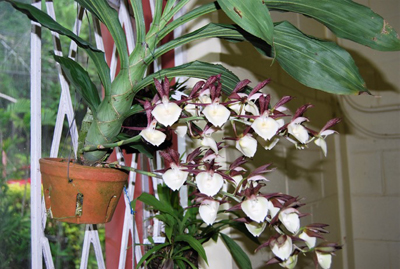

September
Monthly Meeting
10 AM, Sunday
September 18th, 2016
Venue: Horticultural Society of Trinidad and Tobago Headquarters
(Lady Chancellor Road, Port of Spain) This meeting will feature a talk
by Curtis Lutchman on preparing your plants for our orchid show on October
8th and 9th. Also guidelines for entering your plants into the various
classification will be discussed.
There will also be a Raffle. The prize is an Orchid plant.
Will this month be your month to win it?
Don't forget to bring along your flowering orchids for the Monthly
Show Table especially those new members to win a plant prize.
Members who win member's choice get their orchid featured in the newsletter.
Summary of August Monthly Meeting
The meeting was held on August 21st at the Horticultural Society of Trinidad
and Tobago Hall. The Photo Contest and Seedling Growing contest were launched.
Information about the Grenada Orchid Show was given to the members. Any
members interested in attending are asked to contact our Secretary, Judith
at 299-8944.
Members Photography Competition
This monthly meeting will be the deadline for submission of photographs
for the competition. The Society has all rights to the winning photo for
one year. Members needing entry forms are kindly asked to email Anis at
nail_786@hotmail.com or contact at
350-7539.
Dendrobium Culture
Antonio De Gannes gave a very informative lecture on growing Dendrobiums,
which is the second largest group of orchids with over 1200 species. He
advised that selecting plants to grow should be based on the parentage
of particular plant hybrids with emphasis on selecting those with suitable
intermediate to hot growing temperatures and elevation where they are
found in the wild. We should select plants with warm growing parents and
found at sea level.
He grows his dendrobiums in bright light with good air movement. Do not
water plants after 4 pm as this promotes fungal problems. His potting
media is broken red clay blocks and charcoal. He prefers to stay away
from using coconut shell as it breaks down after 1 - 1.5 years at which
point you need to re-pot on time or you can lose your plant. Two key indicators
that your dendrobiums are doing well are each sequential growth being
larger and green root tips. His fertilizer of choice is Nutrex 20-20-20
at ¼- ½ tea spoon per gallon twice per week, applied during
the cooler parts of the day.
The monthly show bench was presented by Mark Robinson, one of our very
knowledgeable student judges.
Members' Choice Plant
Hazra Maraj won the Members' Choice for August with her beautifully flowered
Catasetum (Ctsm.) Memoria Vera Mc Millan 'Little Shaffina' AM/AOS 2007.
This plant is a locally bred hybrid, bred by Carlyle McMillan and named
after his mother in 1997. His hybrid was first awarded by the American
Orchid Society in 1999, with a First Class Certificate (FCC) of 91 points
to the clone Catasetum Memoria VeraMcMillan 'Millenium Queen'. Parent
plants of this hybrid are Ctsm. Sandy Gibson, another locally bred hybrid
and Ctsm. pileatum.

A Diamond Celebration of Orchids Part 2!
Continuing
the TTOS 60th Anniversary Celebrations, our Annual North Orchid Show will
take place on 8th and 9th of October at the Trinidad Country Club in Maraval.
The Chairman for this event is Antonio de Gannes with Co-chair Christopher
Watson. Any member willing to help make this show a great success and
aid in the Diamond celebrations is welcome to contact Antonio or Christopher
to join the Show Committee.
Tickets will be distributed at the September Members Meeting. We are asking
that each member kindly take at least 5 tickets.
Members interested in vending at this show are kindly asked to come prepared
to make payment for their vending space and to fill out their vending
contracts.
Cultural Corner
Cattleyas can be divided into two basic groups based on their number of
leaves on the pseudobulb: unifoliate and bifoliate.
Unifoliate cattleyas (labiata, mossiae, percivaliana) have one leaf per
pseudobulb. Generally quite easy to grow as long as potted while roots
are active, which is generally right after they have flowered. Some types
such as Cattleya labiata and Cattleya trianaei form sheaths and then rest.
The sheaths may begin to turn yellow and die, at which time, if they are
not carefully removed, the flowers buds may rot.
Bifoliate cattleyas (amethystoglossa, bicolor, guttata) have two or more
leaves per pseudobulb. These are very sensitive to potting when not actively
rooting, which must be determined for each species individually. Plants
can be quite large and subject to breakage of the rapidly growing pseudobulbs,
hence good idea to stake psuedobulbs. Many of these produce waxy textured
flowers and spotted flowers.
